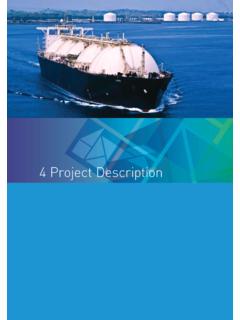Transcription of Dredging and rock removal - INPEX
1 The Ichthys Project Dredging volumes in the Australian context:ProjectOperatorDredge volume (Mm3*)Gorgon Project (WA)Chevron Project (WA) Gas Field Development Project (NT) Phillip Channel Deepening Project (VIC)Port of Melbourne of Gladstone Western Basin Project (QLD)Gladstone Ports * Mm3 = million cubic metresIChThys ProjeCT FACT sheeTDredging and rock removalConstruction of a safe shipping channel to Blaydin Point will be achieved through a combination of Dredging and rock removal , in a program that recognises and protects the environmental values of Darwin s working harbour. Key factsthe proposed Dredging program has been designed to minimise the release of fine sediments by using less intensive Dredging methods over a longer time frame at greater cost to INPEX . Laboratory results confirm that marine sediments in Darwin Harbour are not contaminated by toxins or pollutants and therefore pose no risk to marine life or public offshore dredge disposal site has been selected to avoid impacts on fishing reefs, shipping routes, Darwin s northern beaches and sensitive marine observers will survey a fauna protection zone around the blasting area for a set period of time to minimise the likelihood of marine animals ( dolphins) being present within the zone when blasting and rock removal is required to create a safe shipping channel through Darwin s working harbour, along with a berthing area for tanker vessels arriving at the proposed gas processing facility on Blaydin Point.
2 Dredging and rock removal is required because water depths in the area are currently too shallow for safe access for liquefied natural gas (LNG), liquefied petroleum gas (LPG) and condensate tankers. An additional vessel access area will be created at a module offloading facility on the east side of Blaydin Point, and Dredging will be required to install the gas pipeline through Darwin harbour. IChThys ProjeCT FACT sheeTDredging involves excavation of the seabed and can be done using a range of equipment including backhoe-style and suction-style dredges. The total volume of sediment to be removed in the Dredging program is estimated at million cubic metres. Marine sediments in the area have been surveyed and are shown to consist of sand and gravel overlying fine muds and silts. Laboratory testing in line with national guidelines (see endnote) indicate that these sediments are not contaminated by pollutants; this was expected as the southern portion of east Arm has never been used for industrial purposes.
3 As such, turbid plumes from the Dredging program do not pose a toxicity threat to marine life or human health. The main environmental impacts from Dredging in east Arm result from the release of fine sediments into the water column, which causes turbid plumes. Computer modelling studies indicate that turbid plumes from the Dredging will be mainly confined to east Arm. During spring tides the plumes will be transported upstream and downstream and at the peak of the Dredging program may be visible from the Darwin central business district, the east Arm boat ramp and the elizabeth river bridge. During neap tide conditions, plumes are expected to be considerably smaller and will generally only occur close to the Dredging equipment. Coral and algal communities in east Arm, are not expected to be significantly affected by Dredging activities. Fine sediments will be transported by the tides into shallow coastal areas around east Arm and are predicted to settle in some areas of mangrove vegetation.
4 Estimates from computer modelling indicate that small patches of mangroves (around 28 hectares in total) could receive enough sediment during the Dredging program to impact the health of mangrove trees. While this could cause a reduction in growth of the mangroves, these areas are expected to recover. In addition, around 2 hectares of mangroves could receive sufficient sediment to cause tree deaths. Given that approximately 20,000 hectares of mangrove vegetation occurs around the inner shores of Darwin harbour, the relative scale of the potential impact due to sedimentation is very low, representing less than of the total area of mangroves. INPEX will facilitate the recovery of any areas of mangrove deaths that result from sedimentation caused by Dredging extensive engineering and environmental studies, the Dredging program proposed by INPEX has been designed to minimise the release of fine sediments. This has been achieved by using less intensive Dredging methods over a longer time frame, and will cost INPEX more to complete than a shorter, more intensive program.
5 The Dredging program is estimated to last around 4 years, but this may be reduced depending on factors such as improvements to dredge methodologies, and the availability of Dredging equipment and crews. Dredge footprintBackhoe dredgerTrailing suction hopper dredgerManagement controls for dredgingsome of the key management controls that will be in place during the Dredging program are as follows: environmentally sensitive Dredging methods have been selected to minimise the release of fine sediments. Anchoring plans will be developed to avoid damage to sensitive areas ( corals, rocky reefs and wreck sites). Monitoring of turbid plumes and coral health will be carried out at the protected Channel Island coral community, and Dredging for the pipeline shore-crossing and approach will be suspended if defined protection levels are exceeded. Monitoring of water quality, corals, soft-sediment communities ( marine worms) and coastal sedimentation will be undertaken in east Arm.
6 Regular reports on monitoring results will be publicly available. Darwin Port Corporation will be notified in advance of Dredging activities, so that advice on the dredge program can be issued to other vessel operators in the harbour. If mangrove tree deaths result because of sedimentation from the Dredging program, rehabilitation of the affected areas will be undertaken after the completion of Dredging activities. rehabilitation methods applied will be a combination of natural recruitment, facilitated natural recruitment and active removal An area of submerged rock known as Walker shoal is located within the proposed shipping channel to Blaydin Point, and poses a navigation hazard to Project vessels. The Northern Territory Government also recognises the safety risk the shoal presents to shipping and its potential to constrain future expansion of east Arm Wharf. INPEX proposes to remove the rock at this location. rock removal is undertaken using underwater blasting techniques, where holes are drilled into the rock and packed with explosives.
7 This creates a confined blast, which is directed into the rock and minimises the pulse radiating to the surrounding water. Underwater blast impacts can be dangerous close to the source, potentially causing injuries or even death to marine fauna. The rock removal program will include procedures to manage public safety and to minimise the risk of harm to marine fauna such as dolphins and dugongs. The rock removal program is estimated to last up to 14 months. Alternative techniques to drilling and blasting are being investigated for the removal of the hard rock material within the shipping channel. At this stage, however, it is not possible to confirm whether there are any viable controls for rock removalsome of the key management controls that will be in place during rock removal are as follows: Trained marine fauna observers will survey a fauna protection zone around the blasting area for a set period of time before each blast. If dugongs, dolphins, crocodiles or turtles are spotted, blasting will be delayed until they move out of the fauna protection zone.
8 Blasting operations will only be undertaken during daylight hours to allow for effective visual observation of the fauna protection zones. Confined blasting methods will be used, with micro-delays between charges to reduce peak pressure levels in the surrounding waters. The blasting program will be designed to ensure that no damage occurs to other infrastructure within the harbour such as wharves or pipelines. Advice will be provided to the public on the date, time and duration of blasting activities along with details on the boundaries of safety exclusion is also investigating underwater acoustic monitoring techniques, which if implemented, would complement the visual observation of fauna protection zones. Underwater blasting activity for rock removal in Dampier archipelagoIChThys ProjeCT FACT sheeTEndnoteNational Assessment Guidelines for Dredging 2009, issued by the Department of the Environment, Water, Heritage and the Arts, Canberra spoil disposalThe material to be dredged consists mainly of silts and muds, which are not suitable for land reclamation or onshore construction.
9 The marine sediments removed during Dredging will be transported by trailing suction hopper dredgers and hopper barges and placed at an offshore spoil disposal ground. A preferred offshore spoil disposal ground was selected in consultation with Northern Territory stakeholders and supported through marine surveys and computer modelling. The selected site avoids impacts on fishing reefs, shipping routes, Darwin s northern beaches and sensitive marine indicates that low-concentration turbid plumes from the spoil ground could be transported long distances by spring tides (1 3 days per fortnight), as far as shoal Bay and south West Vernon Island. This effect mirrors natural processes in these coastal areas and is not expected to increase turbidity and sedimentation rates to levels that could significantly affect marine habitats and controls for dredge spoil disposal some of the key management controls that will be in place during dredge spoil disposal are: Undertaking bathymetric surveys before, during and after spoil disposal to assess the accumulation of material on the seabed.
10 These surveys will guide spoil disposal activities and prevent large mounds forming, which will allow for the safe passage of ships over the area. Notifying Darwin Port Corporation so that it can advise other vessel operators in the area of the dredge spoil disposal program readingChapters 4, 7, 11 and 12 of the Ichthys Gas Field Development Project: Draft environmental Impact statementINPEX Level 22, 100 st Georges Tce Perth WA 6000 Phone: 1800 705 010 email: 8, Mitchell Centre 59 Mitchell street Darwin NT 0800the Ichthys Project is operated by INPEX in joint venture with total e&P australiac025-aG-fst-0010_0







